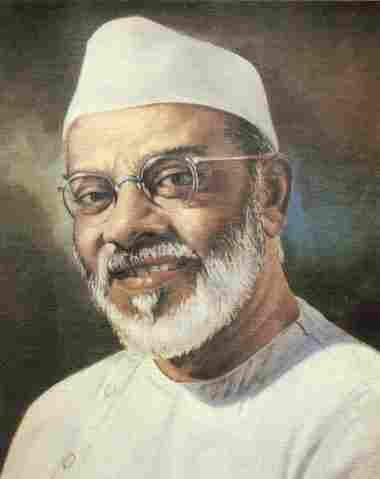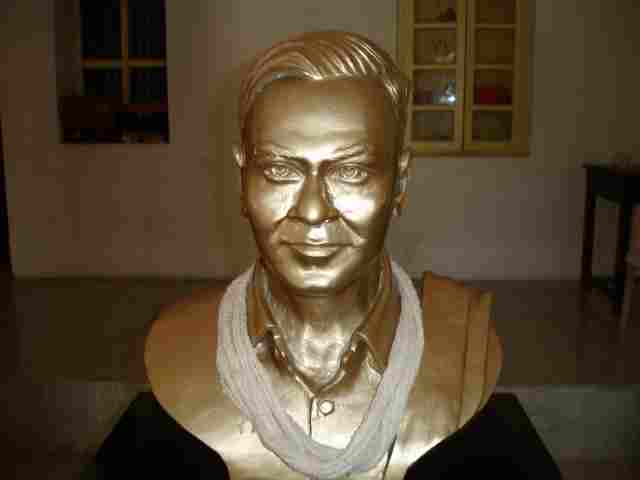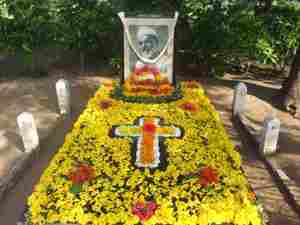Let’s start off with a quick Quiz; Identify the man:
The man was a certified chartered accountant in London for a British company. He went on to become probably the first Indian with a Bachelors Degree in Business Administration. [Our hot-shot youngsters, think of this, a BBA degree in 1928]!
He enrolled for a Masters Degree in Economics from Columbia University. He undertook an exhaustive study of the financial policies and taxation structure prevailing in India. This study so convinced him of British injustice and exploitation that he turned into a passionate nationalist.
Throughout the struggle for Independence and upliftment of India, the Indian Christian community has played a significant role. These freedom fighters are often overlooked and are lost in the pages of history. But it is important to recognize their unparalleled contribution that made India what it is now.
Joseph Cornelius Kumarappa was a veteran Congress leader, a strong supporter of Satyagraha, and encouraged Christian participation in the national movement.
Kumarappa emerged as the most important Indian Christian nationalist involved in the struggle for Swaraj.
Although a layman, Kumarappa had a sound theological understanding which he deployed to great effect in countering the establishment’s criticism of the nationalist campaigns during the Civil Disobedience period.
Kumarappa also wrote a few novels and presented his creative interpretation of the teachings of Jesus in light of Gandhi’s philosophy of Sarvodaya.
A Man of the People
Kumarappa was not a dreamy philosopher but a serious thinker who engaged with the problems of his time. In a bid to make himself more accessible, Kumarappa changed his name from Joseph Chelladurai Cornelius to Joseph Cornelius Kumarappa.
As a champion of rural India, economic justice and ecological thought, Kumarappa suggested that the public should do justice to farmers who were short-changed by the structure of the agrarian economy. Kumarappa advocated local production for local consumption emphasizing ‘ self reliance ‘ and ‘ self sufficiency.’
A meeting of the Planning Commission Advisory Committee has been organised at Rashtrapati Bhavan. Joseph Cornelius Kumarappa arrives in a horse-drawn tonga, but is ordered off the road with the excuse that Jawaharlal Nehru’s motorcade is to pass. His Gandhian sensibilities are incensed and in the meeting he threatens to arrive the next day in a bullock cart, adding for good measure that, in a democracy, a Prime Minister and a bullock-cart driver are equal. Nehru tries to mollify Kumarappa by saying that bullock carts are not allowed on these roads for their own safety, since the road is frequented by military trucks. Kumarappa argues from common sense that if one person is a threat to another then the restriction ought to be placed on the former! This anecdote is justly famous, illustrating as it does both Kumarappa’s world view and his personality.
The Web of Freedom: J C Kumarappa and Gandhi’s Struggle for Economic Justice by Venu Madhav Govindu and Deepak Malghan
A Lucrative Career
Born on January 4, 1892 in Tanjore (now Thanjavur), Joseph Chelladurai Cornelius adopted “Kumarappa”his ancestral family name on joining the national movement in 1929.
Kumarappa’s father Solomon Cornelius was a government officer and a strict disciplinarian. His influence was reflected in Kumarappa’s punctuality and methodical habits. Kumarappa’s mother Esther Rajanayakam was a devout Christian who helped to inculcate in him the moral and spiritual values that were to play an important role in shaping his economic philosophy.
Kumarappa excelled in studies at school and college. After graduating in history from Madras Christian College he decided to pursue a career in accountancy and was sent to England. He qualified as a chartered accountant in London and embarked on a lucrative career as an auditor for a British firm.
After the war ended Kumarappa returned to India and set up an auditing firm in Bombay.
In 1927he went abroad again this time to visit his brother who was living in New York.
Kumarappa stayed and obtained a bachelor’s degree in business administration from Syracuse University in 1928. He transferred to Columbia University in New York City to study for a master’s degree in Economics.
During this period he began accepting invitations to deliver weekend lectures on Indian history and culture to small groups. One of these lectures titled Why then is India poor? was reported in The New York Times and caught the attention of his professor E R A Seligman who suggested Kumarappa base his master’s thesis on it.
Kumarappa agreed and undertook an exhaustive study of the financial policies and taxation structure prevailing in India.
He was shocked to discover that the British authorities had imposed the expenses of their imperial wars on the Indian exchequer. His thesis titled Public Finance and Indian Poverty described in detail the financial irregularities committed by British institutions and indicted them for impoverishing the Indian people by imposing unjust taxes on them. Kumarappa’s biographer M Vinaik writes ‘This study so convinced him of British injustice and exploitation that he turned into a passionate nationalist’
Joseph Cornelius Kumarappa was a bachelor all his life. He said he did not have the time to devote to a family. He was an avid amateur photographer. Photography was his only leisure activity. He used his own equipment to develop and print pictures. In time, Kumarappa acquired a large collection of photographs and negatives.
Leading with the Pen
Gandhiji decided to serialize Kumarappa’s thesis on “Public Finance and Indian Poverty” in the Young India magazine between November 28, 1929 and January 23, 1930.
Kumarappa wrote regularly for Gandhi’s weekly ‘Young India’ of which Kumarappa later became the editor. He used the magazine to mobilize public opinion against the unjust policies and practices of the British in India.
Kumarappa acquired a reputation for bold criticism and in 1931 he was arrested on the charge of sedition and imprisoned. This was the first of his four stays in prison between 1931 and 1944 for a total of four-and-a-half years.
During the ‘Quit India Movement’, he was deeply involved in the underground activities in Bombay along with his Congress colleagues for which he was later arrested. He was sentenced to two and a half years of rigorous imprisonment for three charges and sent to Jabalpur Central Jail until 1945.
In July 1947 he joined the delegation nominated by the Indian government to help India’s economic interest in maritime transport at the meeting of shippers in London.
Since he was also a prominent figure in Congress affairs, he was given a chance to be a member of the All India Congress Working Committee in place of Jay Prakash Narayan in 1947. However, he rejected the offer.
Cornelius was a westernized gentleman, but after meeting Gandhiji he devoted himself fully to the national cause. He adopted an austere lifestyle, wore khadi and embraced the Gandhian philosophy.
An incident took place during this time that illustrates the adjustments Kumarappa had to make. One of his European friends,John Mackenzie, invited Kumarappa to tea shortly after he had switched to khadi. Kumarappa got a friend to help him don dhoti and kurta. On reaching the Mackenzie home, Mrs Mackenzie opened the door and Kumarappa’s instinctive reaction was to doff his Gandhi cap courteously. Much amused, Mrs Mackenzie retorted ‘Kumarappa, you must also learn Indian manners. You mustn’t take off your cap in greeting, but shed your chappals instead!‘
Article in Down to Earth Magazine “A Gandhian Economist ahead of his time”
The Green Gandhian
Several of Gandhi’s followers developed a theory of environmentalism. Kumarappa took the lead in a number of relevant books in the 1930s and 1940s.
He and Mirabehn argued against large-scale dam-and-irrigation projects, saying that small projects were more efficacious, that organic manure was better and less dangerous than man-made chemicals, and that forests should be managed with the goal of water conservation rather than revenue maximization.
The British and the Nehru governments paid them little attention.
Historian Ramachandra Guha calls Kumarappa, “The Green Gandhian,” portraying him as the founder of modern environmentalism in India.
Kumarappa examined such issues as conservation of water and forests effect of erosion and water logging on soil quality and availability of fodder and fuel in the rural economy. He advocated, among other measures, the manufacture of handmade paper from waste paper and grasses and the use of organic manure instead of chemical fertilizers.
“Kumarappa’s writings are strewn with profound ecological consequences though he does not express it in these terms says Ramachandra Guha, “The environmentalists of today are only taking up where he left off.”
Kumarappa exerted his greatest influence when he became head of the All India Village Industries Commission (AIVIC)which had been set up in 1934.
He shifted to AIVIC headquarters in Maganwadi in Wardha district and this was his home for 17 years. Among the programmes he launched to revive village industries were oil-pressing, bee-keeping, paper-making, soap-making and pottery. Nirmal Chandra of the Gandhi Peace Foundation in Delhi says Kumarappa’s efforts went a long way in reviving the self-respect of the villagers.
Lacking support
J C Kumarappa’s ideas did not find much support in political circles.
In 1937, he was made a member of the national planning committee, which had Jawaharlal Nehru as chairperson. But Kumarappa resigned shortly after to protest the unwillingness of the other committee members to put the village at the centre of planning.
In December 1947, a national conference of revenue ministers was held in Delhi and it decided to set up an agrarian reforms committee to suggest methods of improving rural conditions. Kumarappa was appointed chairperson and the committee submitted its report in July 1949, containing several recommendations favouring land reform through decentralisation.
None of the recommendations was taken up at either the Central or state level, as the Nehru government was already committed to a policy of rapid industrialization.
Joseph Cornelius leaves on Gandhi’s Death Anniversary
Effectively marginalised from the political mainstream and disappointed with the government’s economic policies, Joseph Kumarappa spent the last years of his life coordinating and guiding the work of activists and voluntary agencies believing that the Gandhian concepts of village planning could best be implemented by them.
Kumarappa had been troubled by complications arising from high blood pressure for several years and in 1953 his health failed and compelled him to retire from active work.
He settled in the Gandhiniketan ashram near Madurai to be among people engaged in the work dear to his heart.
Shortly after his 68th birthday, he suffered a stroke and was hospitalised in Madras, where he passed away on 30 January 1960.
The last word goes to Ramchandra Guha, “Kumarappa’s ideas failed to find support because he was ahead of his time. The debate of environment versus development that he had anticipated is still raging and the verdict of history may well decide in his favour.”
[Prepared by Newsnet Desk from various inputs- Research by Nishant Mishra]





Very informative article!
Thank you for reintroducing such forgotten nationalist heroes.